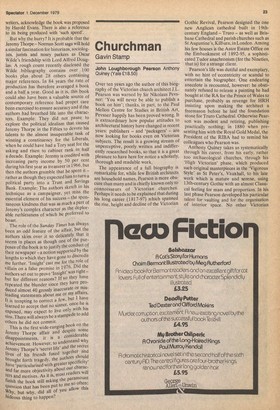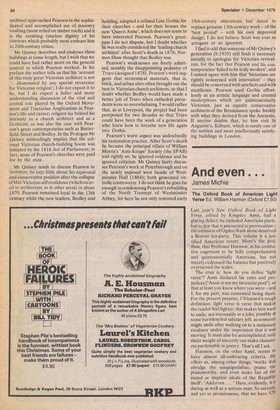Churchman
Gavin Stamp John Loughborough Pearson Anthony Quiney (Yale £18.50) Over ten years ago the author of this biography of the Victorian church architect J.L. Pearson was warned by Sir Nikolaus Pevsner: `You will never be able to publish a book on him'; thanks, in part, to the Paul Mellon Centre for Studies in British Art, Pevsner happily has been proved wrong. It is extraordinary how popular attitudes to architectural history have changed in recent years: publishers — and 'packagers' — are now looking for books even on Victorian subjects. The result is a growing stream of unperceptive, poorly written and indifferently researched books, so that it is a great pleasure to have here for notice a scholarly, thorough and readable work.
The appearance of a full biography is remarkable for, while few British architects are household names, Pearson is more obs cure than many and is chiefly known only to connoisseurs of Victorian churches.
Perhaps it needs to be explained that during his long career (1817-97) which spanned the rise, height and decline of the Victorian Gothic Revival, Pearson designed the one new Anglican cathedral built in 19thcentury England — Truro — as well as Brisbane Cathedral and parish churches such as St Augustine's, Kilburn, in London. Among his few houses is the Astor Estate Office on the Embankment of 1892-95, a sophisticated Tudor anachronism (for the Nineties, that is) for a strange client.
Pearson's life was dutiful and exemplary, with no hint of eccentricity or scandal to entertain the biographer. One endearing anecdote is recounted, however: he obstinately refused to release a painting he had bought at the RA for the Prince of Wales to purchase, probably as revenge for HRH insisting upon making the architect a freemason before he laid the foundation stone for Truro Cathedral. Otherwise Pearson was modest and retiring, publishing practically nothing; in 1880 when presenting him with the Royal Gold Medal, the President of the RIBA had to remind his colleagues who Pearson was.
Anthony Quiney takes us systematically through his career, from his early, rather too archaeological churches, through his 'High Victorian' phase, which produced such original masterpieces in the 'Vigorous Style' as St Peter's, Vauxhall, to his late work which is mature and serene, using 13th-century Gothic with an almost Classical feeling for mass and proportion. In his last phase Pearson developed his particular talent for vaulting and for the organisation of interior space. No other Victorian architect approached Pearson in the sophisticated and accomplished use of masonry vaulting (most relied on timber roofs) and it is the resulting timeless dignity of his interiors which probably most endears him to 20th-century critics.
Mr Quiney describes and analyses these buildings at some length, but I wish that we could have had rather more on the general context in which Pearson worked. In his preface the author tells us that his 'account of this truly great Victorian architect is not . . .illuminated by any special reverence for Victorian religion'; I do not expect it to be, but I do expect a fuller and more understanding discussion of the vital and central role played by the Oxford Movement and Tractarian Anglicanism in Pearson's life and career; religion lay behind his intensity as a church architect and as a Gothicist, as was also the case with Pearson's great contemporaries such as Butterfield, Street and Bodley. In the Prologue Mr Quincy misleadingly implies that the colossal Victorian church-building boom was initiated by the 1818 Act of Parliament; in fact, none of Pearson's churches were paid for by the state.
Mr Quiney tends to discuss Pearson in isolation; he says little about his equivocal and conservative position after the collapse of Mid-Victorian self confidence (whichoccured in architecture as in other areas) in about 1870. Pearson remained loyal to the 13th century while the new leaders, Bodley and Sedding, adopted a refined Late Gothic for their churches — and for their houses the new 'Queen Anne', which does not seem to have interested Pearson. Pearson's greatness I do not dispute, but I doubt whether he was really considered the 'leading church architect' after Scott's death in 1878; Norman Shaw thought that Bodley was.
Pearson's weaknesses are freely admitted, notably the disappointing pedantry of Truro (designed 1878). Pearson's work suggests that economical materials, that is, brick, and urban sites often brought out the best in Victorian church architects, so that I doubt whether Bodley would have made a better job of Truro when cathedral precedents were so overwhelming. I would rather that, as at Liverpool, the project had been postponed for two decades so that Truro could have been the work of a generation who knew how to breathe new life again into Gothic.
Pearson's worst aspect was undoubtedly his restoration practice. After Scott's death he became the principal villain of William Morris's 'Anti-Scrape' Society (the SPAB) and rightly so; he ignored evidence and he ignored criticism. Mr Quincy fairly discusses Pearson's work at Peterborough and on the newly exposed west facade of Westminster Hall (1884); both generated vitriolic controversy. I do not think he goes far enough in condemning Pearson's rebuilding of the North Transept of Westminster Abbey, for here he not only removed early 18th-century alterations but dared to replace genuine 13th-century work — of the 'best period' — with his own improved design; I do not believe Scott was ever so arrogant or so ignorant.
I find it odd that someone of Mr Quiney's generation (b.1935) still finds it necessary initially to apologise for Victorian revivalism, for the fact that Pearson and his contemporaries 'failed to be truly modern', and I cannot agree with him that 'historians are rightly concerned with innovation' — they should be concerned with artefacts and with excellence. Pearson used Gothic effortlessly as an artistic language and created masterpieces which are quintessentially Victorian, just as equally conservative architects of the Renaissance spoke freshly with what they derived from the Ancients. If anyone doubts that, let him visit St Augustin's, Kilburn, which is surely one of the noblest and most intellectually satisfying buildings in London.












































 Previous page
Previous page